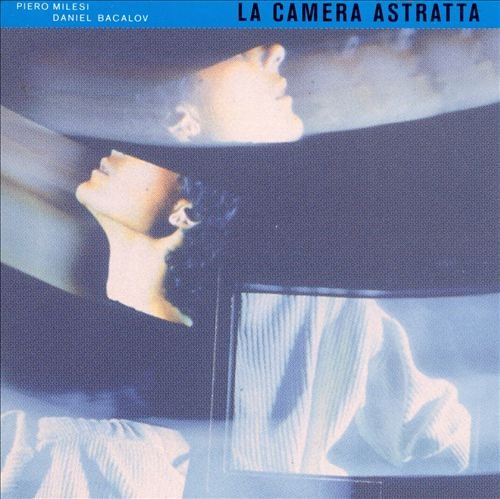Piero Milesi, Daniel Bacalov - La Camera Astratta (1989)

Artist: Piero Milesi, Daniel Bacalov
Title: La Camera Astratta
Year Of Release: 1989
Label: Cuneiform Records
Genre: Classical
Quality: FLAC (tracks+.cue,log,scans)
Total Time: 50:17
Total Size: 279 Mb
WebSite: Album Preview
Tracklist: Title: La Camera Astratta
Year Of Release: 1989
Label: Cuneiform Records
Genre: Classical
Quality: FLAC (tracks+.cue,log,scans)
Total Time: 50:17
Total Size: 279 Mb
WebSite: Album Preview
01. Astratta (Abstract) 3:51
02. Camera 1° Parte (Room Part 1) 9:10
03. Sequenza Ragazze 1° Parte (Girl's Sequence Part 1) 0:58
04. Sequenza Ragazzi (Boys' Sequence) 0:32
05. Acqua (Water) 8:45
06. Sequenza Ragazze 2° Parte (Girl's Sequence Part 2) 1:55
07. Sirocco 5:19
08. Piccoli Sassi (Little Stones) 6:49
09. Perdere Il Tempo (To Lose Time) 5:03
10. Camera 2° Parte (Room Part 2) 8:13
Piero Milesi is an Italian composer who approached minimalism from a unique angle on Modi (Cherry Red, 1982 - Cuneiform, 1984). The six movements of Modi No 1 (1980) is heavily influenced by Steve Reich and achieves the same kind of emphatic transcendence of Michael Nyman's scores. The three movements of Modi No 2 f (1980)or chamber ensemble and soprano represent a substantial innovation of Steve Reich's method. The melody (that has Japanese overtones) is much more relevant, and the fluctuations in the percussive pattern are more elegant and complex. The oscillation reaches a point in which the instruments follow two asynchronous waves of pulses, with the voice floating across both. The piece changes dramatically in the third movement, with the pulse becoming much stronger and the fluctuations becoming much wilder.
Most of his work was for the cinema and the theater, as documented by the soundtracks collected on The Nuclear Observatory of Mr Nanof (Cuneiform, 1986). The 13-minute Mr Nanof's Tango is actually a flute-driven elegy caressed by sympathetic strings and lulled by minimalist repetitive patterns in the strings and keyboards. Excerpts from the one-hour piece The Kings of the Night include The Procession, which creates suspense by releasing a flock of drones, and Three Figurations, a sort of frantic gamelan that generates a sort of tidal wave of sound amid symphonic staccatos. One of the most intriguing selections, The Presence Of The City, is actually a piece (mostly rollicking piano figures) that evokes a lifeless soundscape, possibly a nocturnal one.
The multi-media piece La Camera Astratta (Cuneiform, 1989) was perhaps his most ambitious effort in this field.
Within Himself (Cuneiform, 2000) compiles compositions of the 1980s and 1990s. The three-movement concerto So Soggy (1992) begins with a jazzy Gershwin-ian piano sonata which slowly mutates into a plaintive piano and violin duo over stately organ and funereal percussion. The 16-minute Dentro di Se' runs the gamut from gentle Terry Riley-ian minimalism to lyrical Steve Roach-ian electronica. Avanti La Tre is samples of voices recorded at a train station, and calm instrumental passages. Fuochi Sul Tevere sounds like music for fireworks, in which baroque and circus music are merged in cycles of repetitive patterns.
Most of his work was for the cinema and the theater, as documented by the soundtracks collected on The Nuclear Observatory of Mr Nanof (Cuneiform, 1986). The 13-minute Mr Nanof's Tango is actually a flute-driven elegy caressed by sympathetic strings and lulled by minimalist repetitive patterns in the strings and keyboards. Excerpts from the one-hour piece The Kings of the Night include The Procession, which creates suspense by releasing a flock of drones, and Three Figurations, a sort of frantic gamelan that generates a sort of tidal wave of sound amid symphonic staccatos. One of the most intriguing selections, The Presence Of The City, is actually a piece (mostly rollicking piano figures) that evokes a lifeless soundscape, possibly a nocturnal one.
The multi-media piece La Camera Astratta (Cuneiform, 1989) was perhaps his most ambitious effort in this field.
Within Himself (Cuneiform, 2000) compiles compositions of the 1980s and 1990s. The three-movement concerto So Soggy (1992) begins with a jazzy Gershwin-ian piano sonata which slowly mutates into a plaintive piano and violin duo over stately organ and funereal percussion. The 16-minute Dentro di Se' runs the gamut from gentle Terry Riley-ian minimalism to lyrical Steve Roach-ian electronica. Avanti La Tre is samples of voices recorded at a train station, and calm instrumental passages. Fuochi Sul Tevere sounds like music for fireworks, in which baroque and circus music are merged in cycles of repetitive patterns.

![Bryan Ferry - Bitter-Sweet (2018) [Hi-Res] Bryan Ferry - Bitter-Sweet (2018) [Hi-Res]](https://www.dibpic.com/uploads/posts/2018-11/1543491501_folder.jpg)


![Tim Kliphuis, Maya Fridman, Marc van Roon - Kosmos (2025) [Hi-Res] Tim Kliphuis, Maya Fridman, Marc van Roon - Kosmos (2025) [Hi-Res]](https://www.dibpic.com/uploads/posts/2025-12/1765893448_folder.jpg)
![Milton Man Gogh - Fully Stretched (2025) [Hi-Res] Milton Man Gogh - Fully Stretched (2025) [Hi-Res]](https://www.dibpic.com/uploads/posts/2025-12/1766080588_cover.jpg)
![Cornelius Claudio Kreusch - Scoop (2025) [Hi-Res] Cornelius Claudio Kreusch - Scoop (2025) [Hi-Res]](https://www.dibpic.com/uploads/posts/2025-12/1765893706_folder.jpg)

